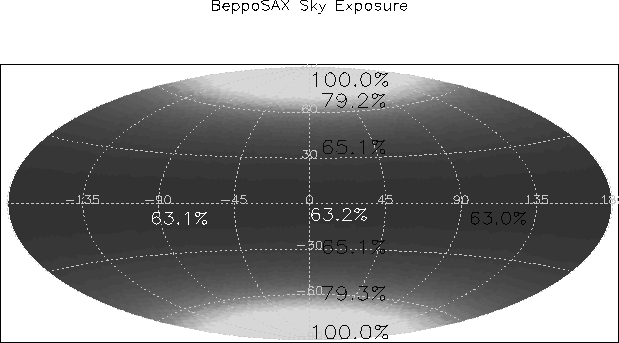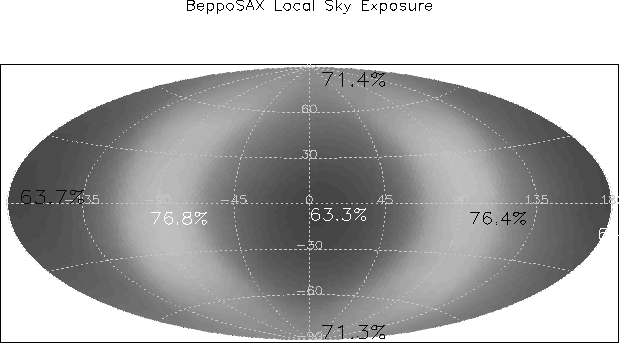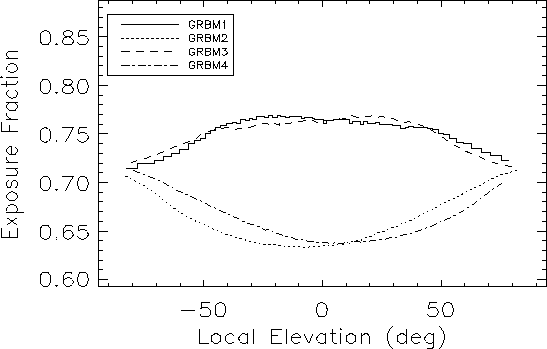 |
![[*]](footnote.png) ;
the angular distance between the centers of two such adjacent pixels
amounts to
;
the angular distance between the centers of two such adjacent pixels
amounts to
For each orbit grid cell (![]() ) (
) (
![]() ),
a visibility vector
),
a visibility vector ![]() (
(
![]() ) assumes 1 when
the
) assumes 1 when
the ![]() -th sky pixel is surely visible, otherwise 0.
Then, a frequency matrix
-th sky pixel is surely visible, otherwise 0.
Then, a frequency matrix ![]() is defined as a function of the
orbit grid cells as follows:
is defined as a function of the
orbit grid cells as follows: ![]() is the time fraction spent
by BeppoSAX within the cell (
is the time fraction spent
by BeppoSAX within the cell (![]() ) during the overall time interval
considered above; eventually, the sky exposure vector
) during the overall time interval
considered above; eventually, the sky exposure vector ![]() is the
product of the following matrices:
is the
product of the following matrices:
![]() .
The same procedure has been used for calculating the BeppoSAX local
sky exposure, provided that for each observation the celestial sky
pixel coordinates are transformed to the local frame of reference.
The original 1 s time resolution of the spacecraft ephemerides has
been adopted, although a higher time resolution could be used as well,
since the arc subtended by the path travelled by BeppoSAX during 1 s
amounts to
.
The same procedure has been used for calculating the BeppoSAX local
sky exposure, provided that for each observation the celestial sky
pixel coordinates are transformed to the local frame of reference.
The original 1 s time resolution of the spacecraft ephemerides has
been adopted, although a higher time resolution could be used as well,
since the arc subtended by the path travelled by BeppoSAX during 1 s
amounts to
![]() , less than the angular dimensions of the
orbit cells; owing to this, a temporal step of
, less than the angular dimensions of the
orbit cells; owing to this, a temporal step of ![]() 17 s, which is roughly
the time needed to cross an orbit cell, could be adopted all the same.
17 s, which is roughly
the time needed to cross an orbit cell, could be adopted all the same.
 |
The figure ![[*]](crossref.png) shows the total sky exposure, expressed in
equatorial coordinates; as expected, the equatorial poles are never
Earth-blocked, given the low inclination of the BeppoSAX orbit,
while the lowest exposure is found at the celestial equator
(
shows the total sky exposure, expressed in
equatorial coordinates; as expected, the equatorial poles are never
Earth-blocked, given the low inclination of the BeppoSAX orbit,
while the lowest exposure is found at the celestial equator
(![]() %). The functional dependence on declination
can be clearly appreciated in fig.
%). The functional dependence on declination
can be clearly appreciated in fig. ![[*]](crossref.png) , where the
small dependence on right ascension has been averaged.
, where the
small dependence on right ascension has been averaged.
In fig. ![[*]](crossref.png) the same celestial sky exposure is shown,
but now referred to a galactic frame of reference. The maximum
exposure regions are obviously found near the equatorial poles.
the same celestial sky exposure is shown,
but now referred to a galactic frame of reference. The maximum
exposure regions are obviously found near the equatorial poles.
 |
Fig. ![[*]](crossref.png) shows the BeppoSAX local sky exposure:
while the exposure for sky regions close to the axes
of GRBM units 1 and 3 is 77-78%, on the other side GRBM units
2 and 4 show a lower exposure amounting to 63-64%.
This difference in the local sky exposure is connected with the
pointing constraints of the BeppoSAX attitude: in particular,
the angle between the Sun and the GRBM unit 2 axis
cannot be greater than
shows the BeppoSAX local sky exposure:
while the exposure for sky regions close to the axes
of GRBM units 1 and 3 is 77-78%, on the other side GRBM units
2 and 4 show a lower exposure amounting to 63-64%.
This difference in the local sky exposure is connected with the
pointing constraints of the BeppoSAX attitude: in particular,
the angle between the Sun and the GRBM unit 2 axis
cannot be greater than
![]() (see chapter 2). This
constraint keeps the unit 2 (and, unit 4 too, since this points
to the opposite direction) in the proximity of the ecliptic;
therefore, once per orbit the spacecraft units 2 and 4 point
to the Earth surface during the BeppoSAX midnight and midday
time, respectively, i.e. when the three bodies are aligned,
according to the following configurations: BeppoSAX-Earth-Sun
and Earth-BeppoSAX-Sun, respectively. This effect is clearly
apparent in fig.
(see chapter 2). This
constraint keeps the unit 2 (and, unit 4 too, since this points
to the opposite direction) in the proximity of the ecliptic;
therefore, once per orbit the spacecraft units 2 and 4 point
to the Earth surface during the BeppoSAX midnight and midday
time, respectively, i.e. when the three bodies are aligned,
according to the following configurations: BeppoSAX-Earth-Sun
and Earth-BeppoSAX-Sun, respectively. This effect is clearly
apparent in fig. ![[*]](crossref.png) , where the functional
dependence of the local exposure on the elevation
, where the functional
dependence of the local exposure on the elevation ![]() above
the BeppoSAX equatorial plane is shown, in correspondence of
the four GRBM unit axes.
above
the BeppoSAX equatorial plane is shown, in correspondence of
the four GRBM unit axes.